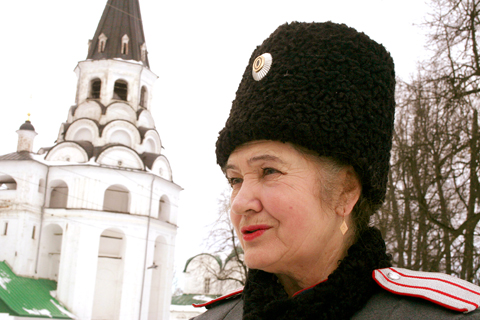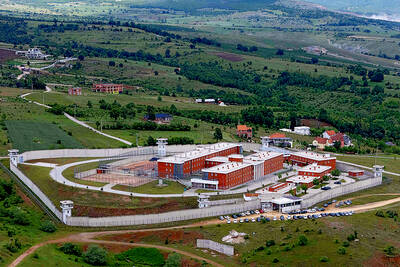Saber sheathed at her side, greatcoat over her shoulders, Yulia Tkachenko patrols the forest with 10 of her men, dressed in the red and black uniforms of the Cossack.
To an outsider it might seem a strange sight. However, Tkachenko, the only woman ataman, or leader of the legendary warriors, sees nothing incongruous in her role.
“Today, the men are a bit weak,” she says. “They are helpless ... the women are stronger. Maybe not physically, but morally certainly, we are the stronger.”

PHOTO: AFP
Tkachenko, a small, gray-eyed woman of 66, is dwarfed by the Cossack troops under her command, each one of whom is at least a good head taller.
However, there is no doubt who is in charge, for it is she who issues the orders assigning each team the territory they are to patrol.
Tkachenko and her men help ensure security in the Alexandrov region, about 100km from Moscow. Working alongside the local police and fire services, they patrol the region on a purely voluntary basis.
“We want our Russia to be strong and it is the role of the Cossacks to help get the country back on its feet,” she says.
The Cossacks were originally warriors in the service of the czar.
Crushed as counter-revolutionaries by the Bolsheviks after the 1917 Revolution, they were persecuted during the Soviet era.
However, in the post-Soviet era, the Cossacks have enjoyed a resurgence of the culture. Today, 740,000 people are recorded as Cossacks in Russia, official statistics show.
About 10 years ago, Tkachenko decided to revive the Cossack community in the Alexandrov region. She mobilized the youth and registered the Cossack presence with the authorities in Moscow.
It was this activism that earned her current position at the head of the 320-strong Cossack troop.
“Yulia Pasalkovna is our mother,” says Vladimir Stukatchov, referring to Tkachenko by her patronymic, the name derived from her father.
“She tells us to do this or that and we obey her with pleasure. It’s not like a chief who gives orders, it’s more like a mother who asks,” the 50-year-old Cossack says.
“Yulia, she’s our Russian Joan of Arc,” he adds.
However, not everyone has accepted her election as head of the troop.
The Cossacks are traditionalists: their values are church, family and country.
One local cossack, Valentin Gusev, who runs a garage in Alexandrov, does not approve of Tkachenko’s status.
“It’s not good that a woman is ataman. There are rules,” he says. “You must not break with the traditions.”
Tkachenko is aware of the hostility among some sections of the community: She says she has even received threats.
“I’m not afraid,” she says. “I’m brave. You only die once, that’s why I’m not afraid of death. I will fight to the end to accomplish my mission.”
She is determined to be worthy of her origins, which according to family legend has her as a descendant of Yermak, one of the most famous Cossack chiefs whose exploits include the conquest of Siberia.
After a hard day’s patrolling, Tkachenko goes home, exchanges her uniform for a dress and applies a little lipstick.
“Out there, I am ataman, I have my uniform and I go to fight,” she says. “But once I come home from combat to the house, I am a woman. I go to the stable, I milk my cow, I get the food ready and I am there for my family.”
As she speaks, she is already preparing a meal of veal liver pastries for her son, her husband and any of the Cossacks who regularly come and eat with them.
“Why rest?” she asks. “I’ll have plenty of time to rest after I’m dead!”

Packed crowds in India celebrating their cricket team’s victory ended in a deadly stampede on Wednesday, with 11 mainly young fans crushed to death, the local state’s chief minister said. Joyous cricket fans had come out to celebrate and welcome home their heroes, Royal Challengers Bengaluru, after they beat Punjab Kings in a roller-coaster Indian Premier League (IPL) cricket final on Tuesday night. However, the euphoria of the vast crowds in the southern tech city of Bengaluru ended in disaster, with Indian Prime Minister Narendra calling it “absolutely heartrending.” Karnataka Chief Minister Siddaramaiah said most of the deceased are young, with 11 dead

By 2027, Denmark would relocate its foreign convicts to a prison in Kosovo under a 200-million-euro (US$228.6 million) agreement that has raised concerns among non-governmental organizations (NGOs) and residents, but which could serve as a model for the rest of the EU. The agreement, reached in 2022 and ratified by Kosovar lawmakers last year, provides for the reception of up to 300 foreign prisoners sentenced in Denmark. They must not have been convicted of terrorism or war crimes, or have a mental condition or terminal disease. Once their sentence is completed in Kosovan, they would be deported to their home country. In

Brazil, the world’s largest Roman Catholic country, saw its Catholic population decline further in 2022, while evangelical Christians and those with no religion continued to rise, census data released on Friday by the Brazilian Institute of Geography and Statistics (IBGE) showed. The census indicated that Brazil had 100.2 million Roman Catholics in 2022, accounting for 56.7 percent of the population, down from 65.1 percent or 105.4 million recorded in the 2010 census. Meanwhile, the share of evangelical Christians rose to 26.9 percent last year, up from 21.6 percent in 2010, adding 12 million followers to reach 47.4 million — the highest figure

LOST CONTACT: The mission carried payloads from Japan, the US and Taiwan’s National Central University, including a deep space radiation probe, ispace said Japanese company ispace said its uncrewed moon lander likely crashed onto the moon’s surface during its lunar touchdown attempt yesterday, marking another failure two years after its unsuccessful inaugural mission. Tokyo-based ispace had hoped to join US firms Intuitive Machines and Firefly Aerospace as companies that have accomplished commercial landings amid a global race for the moon, which includes state-run missions from China and India. A successful mission would have made ispace the first company outside the US to achieve a moon landing. Resilience, ispace’s second lunar lander, could not decelerate fast enough as it approached the moon, and the company has